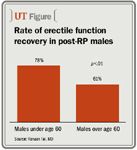Article
Studies shed light on erectile function in prostate cancer patients
Erectile dysfunction is a fact of life for many men who receive treatment for prostate cancer, but methods of measuring post-treatment ED and erectile function recovery suffer from a lack of standardization, according to studies presented at the Sexual Medicine Society of North America 2008 Fall Scientific Meeting.

The good news is that other studies have shown how a number of factors-surgical approach, presence of vascular disease, and nerve-sparing status-may affect erectile function recovery.
One review found that the prevalence rates of ED after prostate cancer treatment and efficacy rates of intervention to treat ED after prostate cancer treatment were very heterogeneous.
Investigators conducted a PubMed search, covering studies from 1996 through 2007 that included 200-plus articles. The review demonstrated that reported rates of ED vary from 24% to 95% based on the type of treatment, including radical retropubic prostatectomy, radiation therapy, cryotherapy, and hormonal androgen ablation.
The investigators commonly observed selection bias and misclassification bias. Forms of selection bias cited were lack of information on patient interest in sex, partner availability, patient age, baseline sexual function, physician factors, nerve preservation, comorbidities for ED, and use and reporting of phosphodiesterase type-5 inhibitors.
Common sources of misclassification bias included use of varied definitions of ED, inconsistent use of validated ED measurement tools, disparate measurement timing, and patient versus researcher data reporting.
These biases detract from the robustness of the research, according to the investigators. They suggested that future studies can minimize biases through proper study design and methodology.
Post-RP erectile function
Another study, from Memorial Sloan-Kettering Cancer Center in New York, was a meta-analysis of reports on erectile function recovery after prostatectomy specifically.
The meta-analysis, which included 23 selected, high-quality studies, found an overall erectile function recovery rate of 59%, reported Raanan Tal, MD, a sexual medicine fellow working with John P. Mulhall, MD, and colleagues. In publications reporting age-stratified outcomes, patients younger than 60 years had a higher rate of erectile function recovery than patients older than 60 (78% vs. 61%, p<.01). Patients who had bilateral nerve sparing surgery had higher erectile function recovery rates than did those who had unilateral nerve sparing (60% vs. 49%, p<.001).
Researchers found little difference in recovery among patients undergoing open and laparoscopic prostatectomy (69% vs. 66%, respectively), but papers on robot-assisted prostatectomy revealed higher reported rates of recovery (86%, p<.01). Still, there are few papers on robot-assisted surgery, so the finding must be interpreted with caution, as its significance is unclear at present, Dr. Tal said.















